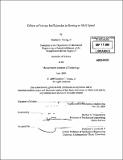Effects of various inefficiencies in rowing on shell speed
Author(s)
Young, Stephen F., Jr
DownloadFull printable version (3.255Mb)
Other Contributors
Massachusetts Institute of Technology. Dept. of Mechanical Engineering.
Advisor
Michael S. Triantafyllou.
Terms of use
Metadata
Show full item recordAbstract
First order predictions were made in determining the effects of various sources of inefficiency in rowing on shell speed. These predictions were then tested using a MATLAB model of the rowing stroke. The model simulates an eight man oared rowing shell and determines average shell speed, stroke rating, power per stroke, and time over a 2000 meter race. Several parameters of the rowing model are manipulated to determine the effects of each source of inefficiency on shell speed. Of the sources tested, three can be attributed to the shell manufacturer, and the others can be attributed to the rowers themselves. The sources of inefficiency tested are wetted surface area, coefficient of friction, dynamic and static weight, stroke length, slide acceleration, and stroke rating. The effects on shell velocity were normalized to determine which sources resulted in the greatest inefficiencies. The ranking of sources from greatest to smallest effect on shell speed are stroke rating, coefficient of friction, wetted surface area, stroke length, static weight, dynamic weight, and slide acceleration.
Description
Thesis (S.B.)--Massachusetts Institute of Technology, Dept. of Mechanical Engineering, 2009. Cataloged from PDF version of thesis. Includes bibliographical references (p. 40).
Date issued
2009Department
Massachusetts Institute of Technology. Department of Mechanical EngineeringPublisher
Massachusetts Institute of Technology
Keywords
Mechanical Engineering.